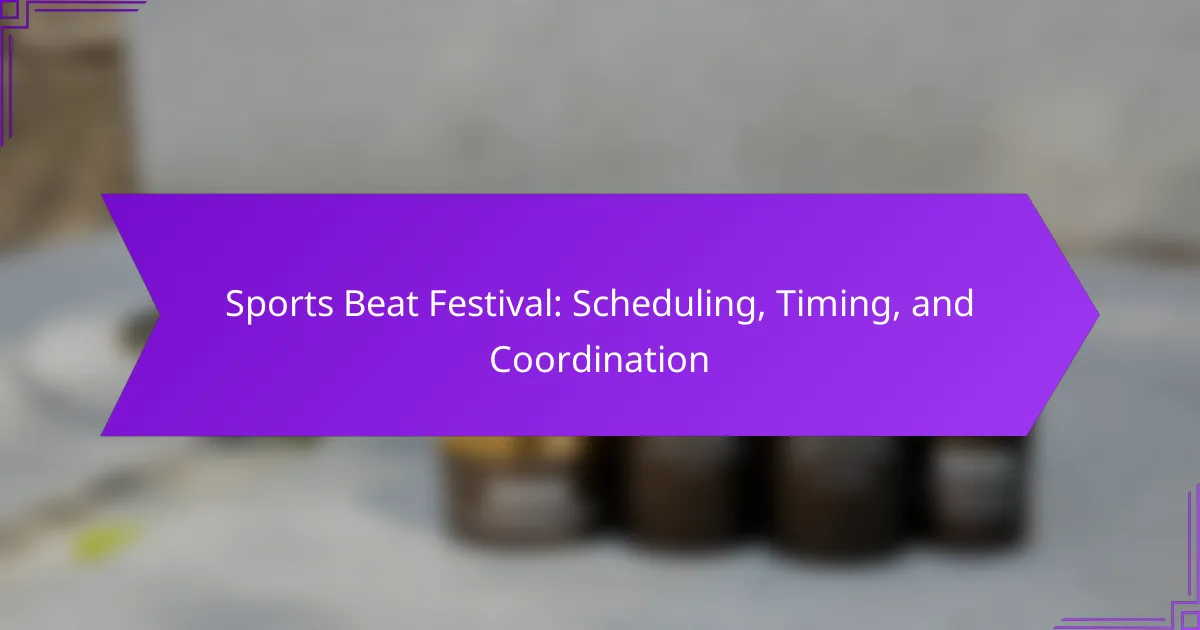The Sports Beat Festival in Los Angeles showcases a selection of iconic venues that prioritize capacity and accessibility for all attendees. Careful venue selection is crucial, taking into account audience size, available facilities, and convenient transportation options. Each venue is designed to accommodate various audience sizes while ensuring compliance with accessibility standards, making the festival enjoyable for everyone.

What are the best venues for the Sports Beat Festival in Los Angeles?
The best venues for the Sports Beat Festival in Los Angeles include iconic locations that offer ample capacity and accessibility. Key considerations for venue selection include audience size, facilities, and transportation options.
Los Angeles Memorial Coliseum
The Los Angeles Memorial Coliseum is a historic venue with a seating capacity of around 77,000, making it ideal for large-scale events like the Sports Beat Festival. Its central location provides easy access via public transportation, including nearby metro stations.
When considering this venue, take into account its rich history and the potential for a vibrant atmosphere. However, be aware of the need for extensive planning regarding logistics, security, and crowd management due to its size.
Dodger Stadium
Dodger Stadium, with a capacity of approximately 56,000, is another excellent option for the Sports Beat Festival. This venue not only offers stunning views but also ample parking and accessibility for attendees.
Keep in mind that while Dodger Stadium is well-equipped for large crowds, it may face challenges with traffic management during peak times. Planning for shuttle services or public transport options can enhance the attendee experience.
Hollywood Bowl
The Hollywood Bowl is a unique venue with a seating capacity of about 17,000, perfect for a more intimate festival experience. Its outdoor setting and acoustics create a distinctive atmosphere that can enhance performances.
However, the Hollywood Bowl’s smaller size means limited ticket availability, so early planning and ticket sales are crucial. Additionally, consider the venue’s accessibility features and parking options to ensure a smooth experience for all attendees.
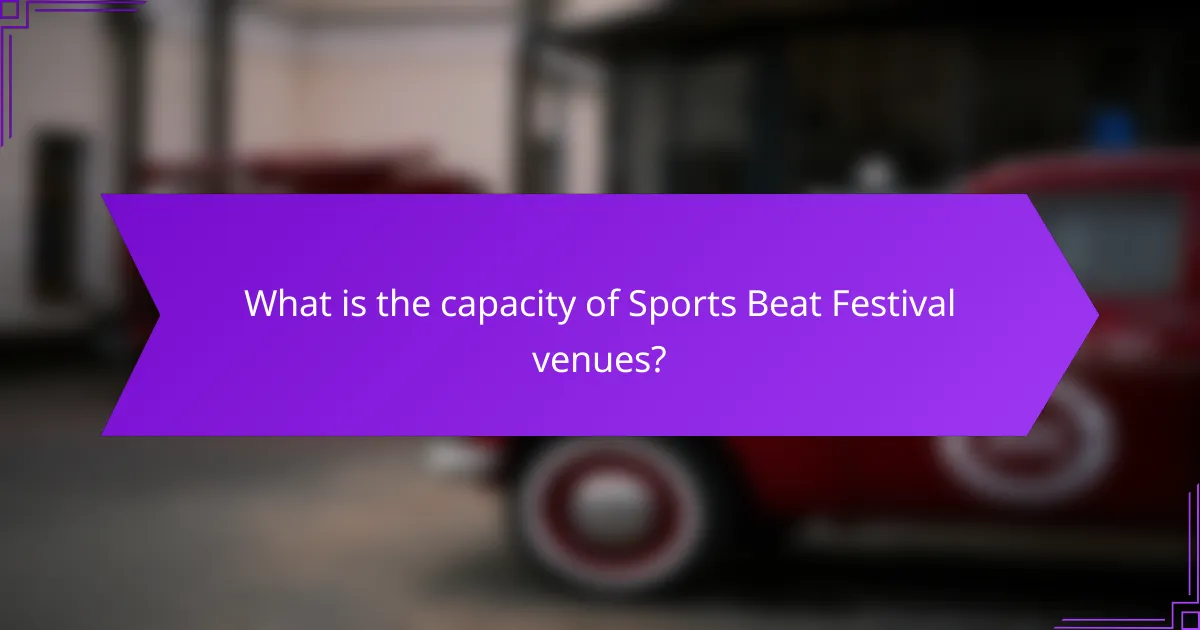
What is the capacity of Sports Beat Festival venues?
The Sports Beat Festival features venues with varying capacities, accommodating different audience sizes and experiences. Understanding the capacity of each venue helps in planning attendance and logistics for the festival.
Los Angeles Memorial Coliseum capacity: 77,500
The Los Angeles Memorial Coliseum, with a capacity of 77,500, is one of the largest venues for the Sports Beat Festival. This iconic stadium is ideal for large-scale performances and events, providing ample space for attendees and activities.
When considering this venue, it’s important to account for crowd management and safety regulations, especially given the high capacity. Organizers should ensure adequate facilities and services to handle the influx of visitors.
Dodger Stadium capacity: 56,000
Dodger Stadium can accommodate up to 56,000 guests, making it another popular choice for the Sports Beat Festival. Its spacious layout allows for a vibrant atmosphere, perfect for music and entertainment events.
Event planners should focus on accessibility and transportation options for attendees, as the stadium’s location can lead to heavy traffic during peak times. It’s advisable to provide clear directions and parking information to enhance the visitor experience.
Hollywood Bowl capacity: 17,500
The Hollywood Bowl, with a capacity of 17,500, offers a more intimate setting for the Sports Beat Festival. This venue is renowned for its acoustics and scenic backdrop, making it a favorite for smaller performances.
When selecting the Hollywood Bowl, consider the unique experience it provides, as well as the need for advanced ticketing strategies to manage demand. Ensuring a seamless entry process will enhance the enjoyment for attendees at this picturesque venue.

How accessible are Sports Beat Festival venues?
The Sports Beat Festival venues prioritize accessibility, ensuring that attendees with different mobility needs can enjoy the event. Most locations are designed to comply with accessibility standards, providing features such as ramps, designated seating, and accessible restrooms.
Public transport options available
Public transport is a key aspect of accessibility for Sports Beat Festival venues. Many locations are well-served by local buses and trains, making it easy for attendees to reach the festival without needing a personal vehicle. Check local transit schedules for routes that stop near the venue, as they often include accessible options.
For example, major cities hosting the festival may offer dedicated shuttle services during the event, which can further enhance convenience. Always verify the accessibility of these transport options ahead of time to ensure a smooth journey.
Parking facilities and accessibility features
Parking facilities at Sports Beat Festival venues typically include designated accessible parking spaces close to the entrance. These spaces are reserved for vehicles displaying the appropriate permits, ensuring that attendees with disabilities can access the venue easily.
It’s advisable to arrive early, as accessible parking spots can fill up quickly, especially during peak times. Additionally, some venues may offer valet services or drop-off zones to assist those who require extra support. Always check the venue’s website for specific parking details and any associated fees.
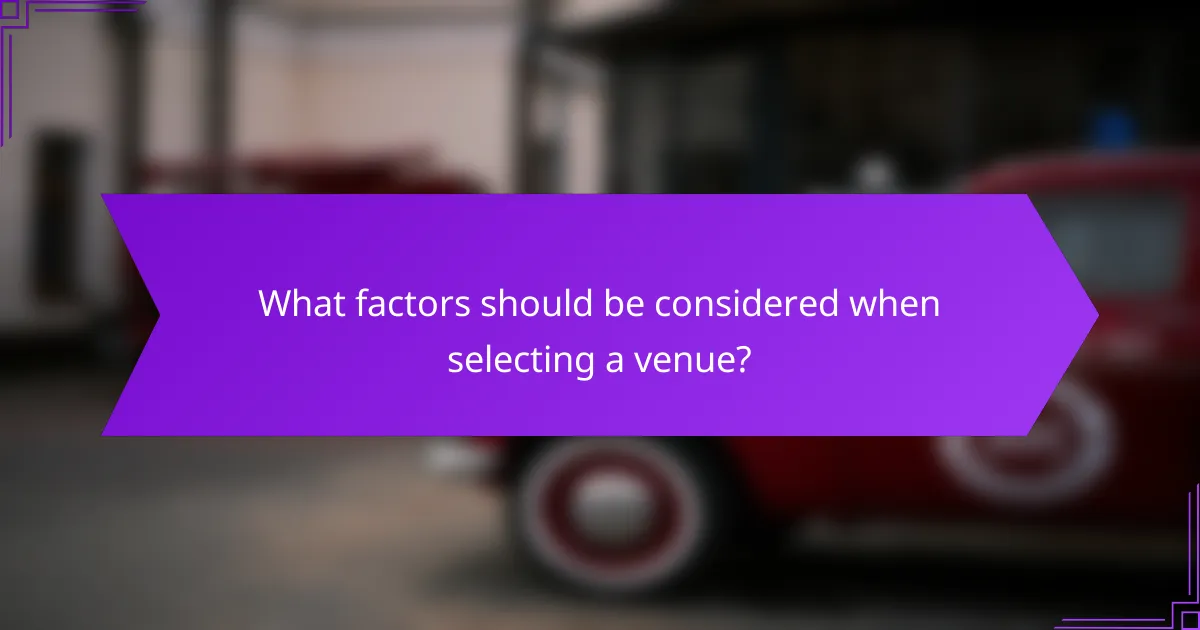
What factors should be considered when selecting a venue?
Selecting a venue for a sports beat festival involves evaluating several key factors that impact the event’s success. Important considerations include location, transportation access, capacity, and layout suitability, all of which contribute to attendee experience and logistical efficiency.
Location and transportation access
The venue’s location is crucial for attracting attendees and ensuring convenience. It should be situated in a well-known area with good visibility and accessibility. Proximity to public transportation options, such as bus and train stations, can significantly enhance attendance.
Consideration of parking availability is also essential. A venue with ample parking space or easy access to nearby parking facilities can accommodate those who prefer to drive. Additionally, check for any local regulations regarding traffic management during large events.
Capacity and layout suitability
Capacity is a vital factor in venue selection, as it must align with expected attendance numbers. Choose a venue that can comfortably accommodate the audience while allowing for safe movement and engagement. A space that is too small can lead to overcrowding, while a venue that is too large may dilute the atmosphere.
Layout suitability involves assessing the venue’s design for various activities and stages. Ensure that the layout supports the planned events, such as performances, workshops, and vendor areas. Flexible spaces that can be easily adapted to different setups are often ideal for dynamic festivals.
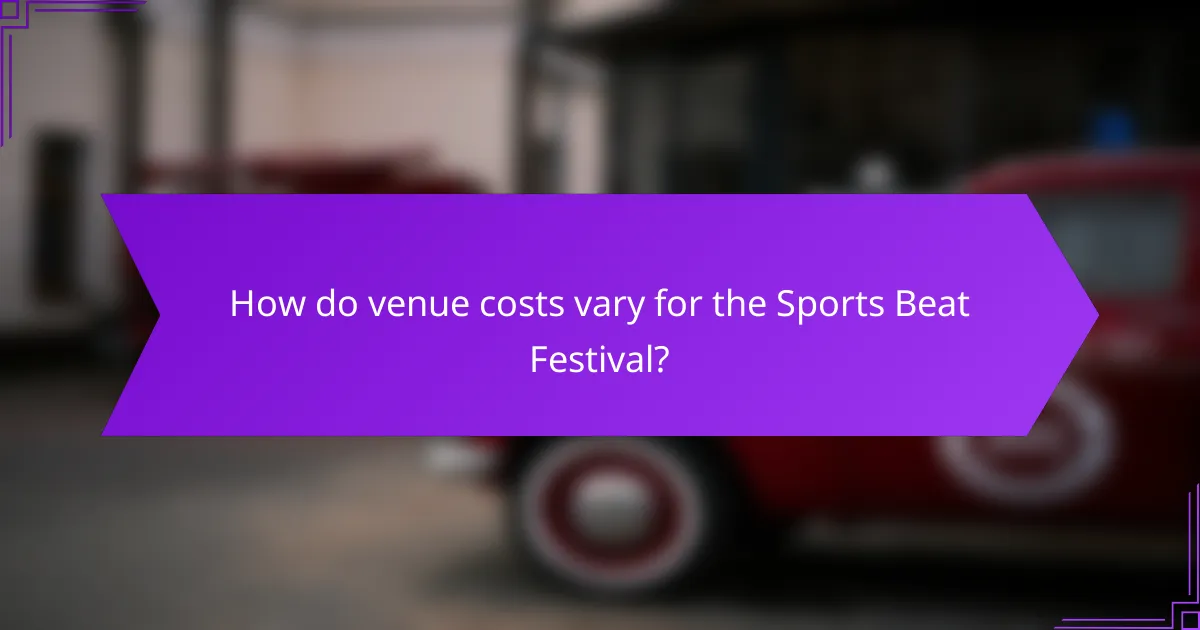
How do venue costs vary for the Sports Beat Festival?
Venue costs for the Sports Beat Festival can fluctuate significantly based on location, size, and facilities offered. Major urban centers typically demand higher rental fees, while smaller venues may provide more budget-friendly options.
Rental fees for major venues
Rental fees for major venues can range from several thousand to tens of thousands of dollars per day, depending on the venue’s capacity and prestige. For instance, a prominent stadium in a major city might charge upwards of 50,000 USD for a single day, while a smaller arena could be available for 10,000 to 20,000 USD.
When selecting a venue, consider not only the rental fee but also the potential for higher ticket sales due to location and capacity. A venue that can accommodate more attendees may justify a higher cost through increased revenue.
Additional costs for services and amenities
In addition to rental fees, organizers should budget for various services and amenities that enhance the festival experience. These can include security, insurance, sound and lighting equipment, and catering services. Depending on the scale of the event, these additional costs can add anywhere from 20% to 50% to the overall venue expense.
It’s advisable to obtain detailed quotes from service providers well in advance and consider bundling services for potential discounts. Always review contracts carefully to understand any hidden fees that may arise during the festival planning process.
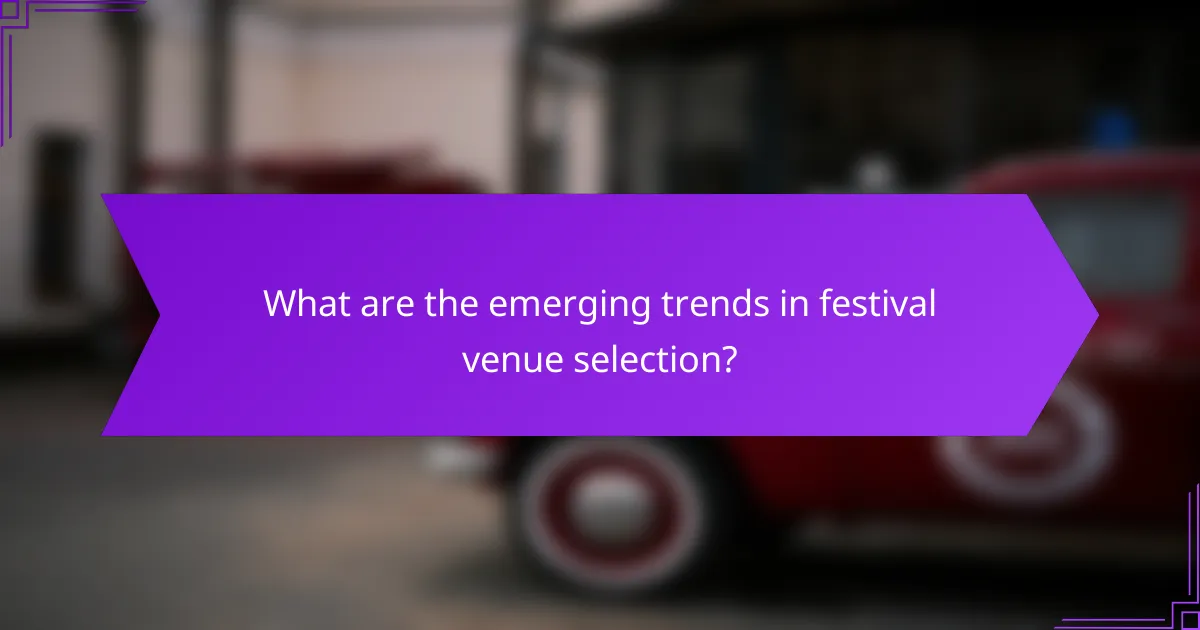
What are the emerging trends in festival venue selection?
Emerging trends in festival venue selection focus on sustainability, technology integration, and community involvement. These factors not only enhance the festival experience but also ensure that events are environmentally responsible and socially engaging.
Focus on sustainability and eco-friendly practices
Many festivals are prioritizing sustainability by choosing venues that support eco-friendly practices. This includes selecting locations that utilize renewable energy sources, implement waste reduction strategies, and promote recycling initiatives.
Event organizers can consider venues with green certifications or those that have demonstrated a commitment to environmental stewardship. For example, venues that offer composting services or have extensive green spaces can significantly reduce the festival’s carbon footprint.
Integration of technology for enhanced experiences
Technology is increasingly being integrated into festival venues to improve attendee experiences. This includes features like mobile apps for navigation, cashless payment systems, and augmented reality installations that engage visitors in unique ways.
When selecting a venue, organizers should assess the availability of high-speed internet and Wi-Fi access, as these are crucial for effective technology integration. Venues that offer robust technical support can enhance the overall festival experience.
Community engagement and local partnerships
Engaging with the local community is vital for successful festival venue selection. Collaborating with local businesses and organizations can create a sense of ownership and pride among residents, leading to greater attendance and support.
Organizers should explore partnerships with local artists, food vendors, and cultural institutions to enrich the festival’s offerings. This not only boosts the local economy but also fosters a vibrant atmosphere that reflects the community’s unique character.



